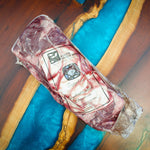
Chapter 5: Beef as an Iron Source - Vitality in Every Bite
Iron, an essential mineral for our well-being, takes center stage in beef, making it a vital source of this micronutrient. This chapter delves into the significance of beef as a powerhouse of heme iron, exploring how it contributes to maintaining optimal iron levels in the body. From preventing iron deficiency anemia to supporting cognitive function, discover the profound impact of beef on vitality and overall health.
The Role of Heme Iron: Beef boasts a unique form of iron called heme iron, which is found in animal tissues. Unlike non-heme iron from plant sources, heme iron is more efficiently absorbed by the body. This makes beef an invaluable dietary choice for individuals at risk of iron deficiency, a condition that can lead to fatigue, weakness, and impaired cognitive function.
Preventing Iron Deficiency Anemia: Iron deficiency anemia is a widespread health concern, particularly among certain demographic groups. The heme iron in beef plays a crucial role in preventing and addressing this condition by supporting the production of hemoglobin—a protein responsible for transporting oxygen in the blood. Adequate iron intake from sources like beef ensures the body's ability to produce healthy red blood cells.
Cognitive Function and Iron: Iron is essential for cognitive function, and beef provides a readily absorbable source of this vital mineral. From supporting neurotransmitter synthesis to ensuring optimal oxygen supply to the brain, iron in beef contributes to maintaining mental alertness and overall cognitive well-being.
Facts About Beef as an Iron Source:
-
Heme Iron vs. Non-Heme Iron: Heme iron, found in beef, is more easily absorbed by the body compared to non-heme iron from plant sources. This bioavailability is a key factor in addressing and preventing iron deficiency.
-
Optimal Iron Absorption: The absorption of heme iron is less influenced by other dietary factors, such as the presence of phytates and polyphenols, which can hinder the absorption of non-heme iron. This makes beef a reliable source of iron even in varied dietary contexts.
-
Iron Content in Different Cuts: While all cuts of beef contain iron, the content may vary. Organ meats, such as liver, are particularly rich in iron. Choosing a variety of cuts ensures a diverse nutrient intake.
-
Combating Fatigue: Iron deficiency is often associated with fatigue and weakness. Incorporating iron-rich foods like beef into the diet can play a significant role in combating these symptoms and promoting overall vitality.
-
Complementary Nutrients: Combining iron-rich foods, such as beef, with vitamin C-rich foods enhances iron absorption. Consider pairing beef with vegetables or fruits high in vitamin C to optimize the benefits of iron intake.
Understanding the pivotal role of beef as an iron source underscores its significance in promoting vitality and preventing nutritional deficiencies. By incorporating a variety of beef cuts into a balanced diet, individuals can actively contribute to maintaining optimal iron levels and supporting overall health and well-being.





